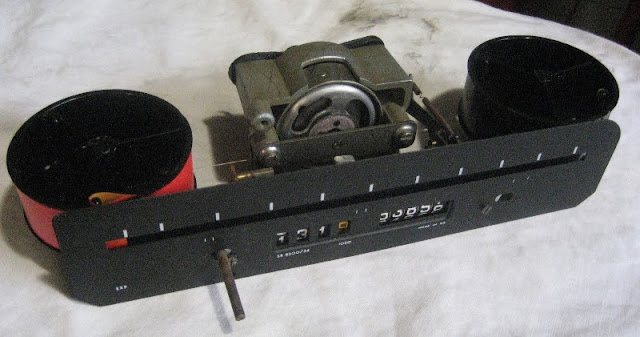The dashboard has been progressing on and off over the past year and a half. Over that time I have sanded back the woodwork, filled, coloured and sprayed with Marine clear. I have also cleaned up switches and fixed bad contacts, resprayed the metalwork and cleaned up the chrome surround.
The Forward/Neutral/Reverse switch is also mounted.
To put it in perspective here is the original. It looks better in the photo than is actually was. There were lots of cracks and blemishes. You can see the finish lifting off the glove box cover on the far left of the picture. It was like that in lots of other places but to a smaller extent.
The "Rootes Group" insert seen here (which filled in the clock hole as it was seldom fitted) is now dark blue, semi transparent and back-lit.
The Oil pressure gauge (to the right of the Rootes Group badge above) has now been replaced with three small push buttons - Trip reset, Up and Down (for contrast etc.). The Amp meter (far left gauge in original) is now a colour LCD temperature gauge which will tell me the engine bay battery pack temperatures.
Here is the fully restored dashboard without the speedo cluster.
Note that the "Lights" switch has moved to the far left where the choke was. The old hole vacated by the "Lights" switch now has the Forward/Neutral/Reverse switch. I have not changed any holes or mountings in the dash.
Close up. I have also changed the indicator lights for the hexagonal version used in the slightly earlier Vogue. I prefer them.
The heater controls bezel covers that darker section.
The reason the speedo is missing in the above picture is that, like most rear wheel drives cars (not all), the speedometer is operated by a cable running off the gearbox. I've removed the gearbox!
The small cable coming out the side of the tail shaft extension housing is the speedo cable.
(Later edit: Added red circle - I hate it when you can't easily see what someone is talking about!)
So I will be running a speedo that is driven from an electronic signal from my controller that tells me the motor speed. Since the motor is attached firmly to the tail shaft, it tells me road speed. It does mean doing a digital speedo and I briefly fooled around with the idea of driving the old one with a stepper motor or synchronous motor but it plain got too hard. So an LCD display it will be - since that is what I do for a living it should be no problem.
The original speedo mechanism removed from the housing. A mechanical wonder. Still working perfectly after 45 years (except for the faded ribbon). Note the trip reset shaft that is responsible for the hole in the perspex front seen a few pictures down.
I am now working on finishing the Speedometer cluster. The Speedometer, ODO, Trip, State of Charge (fuel gauge) and Current meter software has been written and tested. I currently have all these on one 60 x 50 mm display but they will be spread out across the three displays when finished.
The software is based on one of our company's transceiver control heads so I had a running start.
This is the original housing with the mechanical parts (above picture plus two gauges) removed - then a coat of black paint.
I have made covers for the two oval holes in the back that were left by the old fuel and water temperature gauges.
The big hole in the centre back (picture below) will have a DB15 connector for the cluster wiring. I'll just plug up the dashlight holes.
I made up an aluminium 'L' section with holes in the front for LCD displays.
I'll be using a 128 x 64 pixel 60 x 50mm monochrome reflective LCD for the actual speed display - so direct sunshine won't be a problem.
Two 16 character x 2 line white on blue LCD displays go at either side of the speed display.
The metal frame in the foreground was made from the old front panel of the original speedo.
It's funny how some things annoy you. In this case, I was annoyed that it cost $80 to have this water-jet cut. My nibbler just wouldn't have done it.
Some captive nuts so I can secure the 'L' frame into the housing. I was going to use "nutserts" but the 3mm ones didn't pull in properly (I think I overdrilled the holes) so I used these brass ones that you secure with a centre punch and a hammer.
The whole lot assembled without the displays. The hole in the perspex was for the old mechanical trip reset.
About the only thing I can think of to put there is a 5mm LED - it fits perfectly.
























